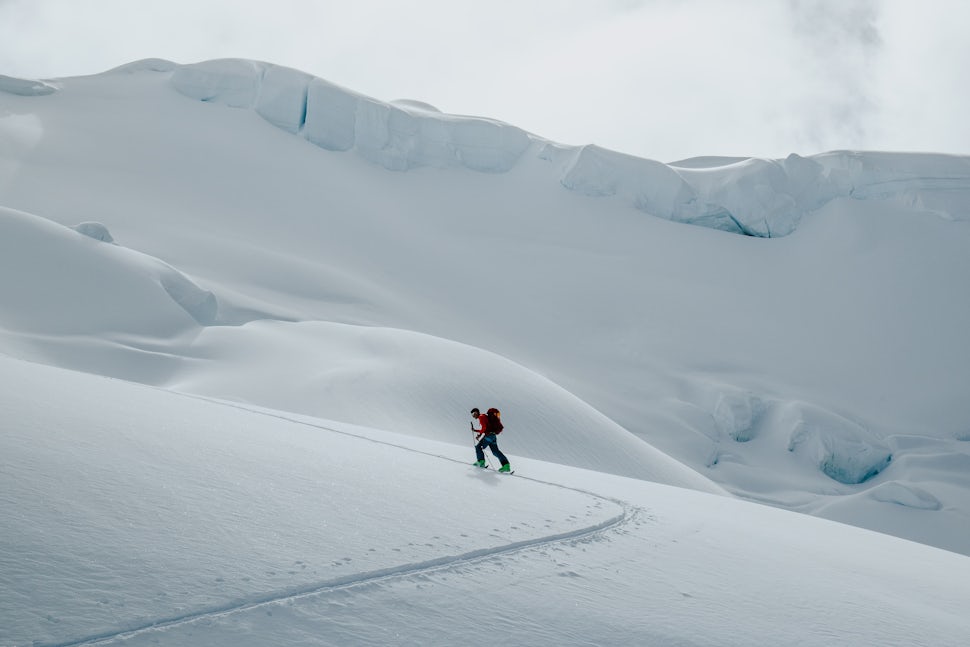An Introduction To Ski Touring
Enjoy the peace and quiet of the backcountry and untracked powder.

Where I live in Tirol, Austria, ski touring is gaining popularity at such a high rate. People have taken up touring for all kinds of reasons. Some simply do it to build up their fitness, while others love the adventure of heading away from the crowded resorts and out in to the backcountry. If you love exploring the outdoors and want to try a new challenge this winter, why not give ski touring a try.
What exactly is ski touring?
Ski touring can sometimes be confused with cross country skiing, backcountry skiing and telemarking, as it shares some similarities with them.
Essentially, ski touring is about climbing up a mountain with your skis on (known as skinning) and skiing back down again. Whilst most people associate ski touring with backcountry skiing as it often involves exploring areas outside of a ski resort, touring up the trail within resort boundaries is also popular with ski tourers in Europe.
Do you need special equipment?
Just as ski technology has developed over the years, so has ski touring equipment. While there are still options out there that allow you to tour with standard alpine setup by inserting a special device between your bindings or with bindings such as the Marker Baron or F12, this heavy setup is ok to give you a taster of the sport but the weight will make it much less enjoyable. If you do want to give touring a go, the best option is to rent a touring setup for a day or two and see if you enjoy it.
What is the difference?
Most touring skis are very similar to normal skis in their size and shape, but are generally a lot lighter. Then you have touring boots, which also share a lot of similarities with alpine boots. Their main differences are again in their weight, their compatibility with special touring bindings and also the option to switch between a loose walk mode and a tighter, stiffer ski mode. Many tourers also prefer to take telescopic poles instead of fixed length ski poles to make steeper ascents more comfortable.
Next are the special bindings to help you tour. Touring bindings, also known as tech or pin bindings, work slightly differently than alpine bindings. The front toe piece usually consists of two pins that clip in to the front of your boot. The back section of the binding stays unattached for touring and allows you to clip in for the descent. This pin binding setup allows you to walk comfortably for long periods of time and save on weight compared to older frame bindings. This year the touring binding market has increased with some of the big manufacturers adding their take on the classic tech binding to cater to different kinds of tourers, and some options that are a hybrid between a pin binding and an alpine binding have been released.
Finally, you'll need some skins. These are custom cut for each pair of skis. They are stuck on to the bases of the skis which allows you to climb up the mountain without sliding backwards. Once you are ready to descend, you simply take them off, switch your boots and bindings back in to ski mode, and off you go.
Where can you do it?
One of the awesome things about ski touring (at least in Europe) is that you can do it almost anywhere. If you want to use it as a way to get out in to the backcountry, it's perfect. There are all kinds of different tours, from easy, predominantly flat ones, to more challenging multi-day routes that cross mountain ranges. And if you don't fancy heading out in to the backcountry, you'll find many resorts in Europe are also welcoming to ski tourers in resorts too, with some even opening the resorts one or two evenings a week for night touring, where you can tour up the piste safely without having to worry about the groomers. You may even find resorts with touring routes on the piste map that allow you to tour up away from the slopes then ski back down them at the end. With all resort touring, just check on the rules for each particular resort. If they allow touring up the piste (which some do) remember to follow the FIS rules of conduct and keep to the side of the slope.
Who can do it?
One of the awesome things about ski touring is that almost anyone can do it. Walking up a mountain on skis does require some level of fitness, but when you start out, just take it slowly. As with anything, the more you do it, the easier it becomes. You don't need to be a pro skier to love touring either, as there are touring routes for all levels of skier. If you are heading on a tour in to the backcountry then you should have thorough knowledge on avalanche safety and a strong level of skiing, but if you're staying in the resort then you can often choose to ski back down the piste.
We want to acknowledge and thank the past, present, and future generations of all Native Nations and Indigenous Peoples whose ancestral lands we travel, explore, and play on. Always practice Leave No Trace ethics on your adventures and follow local regulations. Please explore responsibly!
Do you love the outdoors?
Yep, us too. That's why we send you the best local adventures, stories, and expert advice, right to your inbox.


















